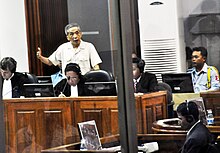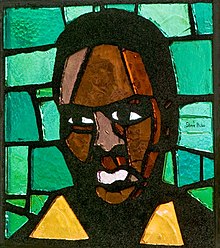Khmer Rouge
The Khmer Rouge (Khmer: Kmae Krahaam; French for "Red Khmer") was a Stalinist, Maoist militant group in Cambodia. They took over Cambodia in 1975 and lost power in 1979.




The Khmer Rouge government committed the Cambodian genocide.
History
changeThe Khmer Route took over the capital city of Cambodia, Phnom Penh, on 17 April 1975. They named the country Democratic Kampuchea. Their leader was Pol Pot (formerly called Saloth Sar). Immediately, they forced everyone out of the cities and effectively turned the whole country into a giant labor camp.
The Khmer Rouge were defeated by the Vietnamese in January 1979. However, the international community continued to recognize the Khmer Rouge as the government of Kampuchea for a decade after they were defeated. Therefore, the Khmer Rouge held a seat in the United Nations until 1989.
In 1999, the Khmer Rouge disbanded.
According to Henri Locard:[1]
The Khmer Rouge regime [was] the ultimate twentieth-century [example] of the totalitarian state. Using sheer violence and terror, a small clique [took] power. [It saw itself as] messianic [with a] mission to bring happiness and prosperity faster than any of its revolutionary model and competitors. It came to control every aspect of social and private life. No one was allowed to [hold or] express any form of opposition.
On 17 April 1975, the Khmer Rouge captured Cambodia's capital city, Phnom Penh, and took control of the country.[2] They renamed it "Democratic Kampuchea." This ended the Cambodian Civil War and began the Cambodian genocide.[2]
Beliefs
changeThe Khmer Rouge were a "fanatical Communist movement ... which imposed a ruthless agenda of forced labor, thought control, and mass execution" across Cambodia.[3] Most members were teenage peasant boys.[4]
The Khmer Rouge believed the people in Cambodia's cities had been poisoned and corrupted by the ideas of Western capitalism.[5] They wanted to return Cambodia to "Year Zero," a time when everybody in the country was a rural farmer. They thought this would create an agrarian socialist utopia - a perfect, farm-based society without social classes, where people would share property.[5]
They did not believe that money, free markets, or educated professions (like medicine, engineering, law, or teaching) should exist. To the Khmer Rouge, being a poor farm worker was the only acceptable lifestyle. They viewed educated people (including qualified professionals of all kinds) as a threat.[5]
Victims
changeHistorians cannot say exactly how many people were killed in the Cambodian genocide. Most estimates say that between 1,400,000 and 2,200,000 Cambodian people were killed. This was between 20% and 30% of Cambodia's population at the time. (Other estimates range from 700,000 to 3,000,000 victims.)
In his 2005 article, Henri Locard wrote:[1]
Between 17 April 1975 and 7 January 1979 the death toll was about 25% of a population of some 7.8 million; 33.5% of men were massacred or died unnatural deaths [and so did] 15.7% of the women ... 41.9% of the population of Phnom Penh [was killed].
Related pages
changeReferences
change- ↑ 1.0 1.1 Locard, Henri 2005. State violence in Democratic Kampuchea (1975-1979) and its retribution (1979-2004). European Review of History 12, 1, 121-143. The quotation includes some changes to the published summary. These changes were made to make the quotation readable in Simple English; the sense of the summary has not been changed. [1] Archived 2021-10-31 at the Wayback Machine
- ↑ 2.0 2.1 "Day One: April 17, 1975". United States Holocaust Memorial Museum. Retrieved 2024-10-23.
- ↑ "Cambodia 1975-1979". United States Holocaust Memorial Museum. April 2018. Retrieved 2024-10-23.
- ↑ "The Cambodian Genocide: Origins, Genocide, and Aftermath" (PDF). Illinois Holocaust Museum & Education Center. Retrieved 2024-10-25.
- ↑ 5.0 5.1 5.2 "Khmer Rouge Ideology". Holocaust Memorial Day Trust. Retrieved 2024-10-24.